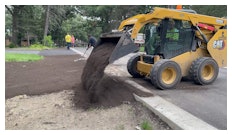
In the landscape and lawn care industry, there’s always room to increase profits by simply selling more to your repeat customers. These clients have gained your trust, they enjoy the work you do for them and are more willing to order additional lawn jobs based on your recommendations. As the professional in the industry, your honest opinion matters and is trusted and, in the end, will turn into profits for your business.
SiteOne hosted its National Virtual University on Nov. 30, a virtual event with industry leaders to teach lawn and landscape business owners ways to improve the services they offer, their preventative care, their business management skills and more. The “Sell More to Your Existing Clients: The Grow Group” webinar was hosted by Marty Grunder, president and CEO of Grunder Landscaping Co. and The Grow Group, based in Miamisburg, Ohio. He presented techniques on how to grow a lawn and landscaping business with some tactics that helped him grow his own business. According to Grunder, it starts with selling more to his existing clients.
1. Determine Your Ideal Client
What is an ideal client? This client helps your company make money and is pleasant to do business with. The ideal client, Grunder says, is profitable and enables you to grow and reinvest in your team while maintaining cash flow. They are enjoyable. In other words, they are easier to work with and they have potential to bring revenue with years to come and possibly provide potential leads. Your ideal clients are:
- High-end residential property owners
- Looking for highest quality, not the low price
- In neighborhoods you already work in
When you have identified your ideal client, sell to them. You can prioritize sales that will best fit your company’s long-term goals.
 ©moodboard-stock.adobe.com
©moodboard-stock.adobe.com
2. Communicate with Your Client
When you arrive to the site, ring the doorbell and take a couple of steps back. Be sure to introduce yourself and explain what work you will be completing for them. Things to mention:
- Your name and crew members.
- Tasks agreed on. No surprises!
- How long it will take to complete the task.
- What you will or will not need from them.
- Suggest they come to you for anything they would like to get done.
- Offer a walk around when job is complete to ensure their satisfaction.
“Think about the little things you can do to demonstrate showmanship that make a difference that can help with the communication with your client,” says Grunder.
3. Selling More to Existing Clients
This is the easiest, more cost-effective way to grow your business. Some best practices to keep in mind are to send the crew that is already familiar with the site. Your client will likely be more comfortable with your crew and trust that they will continue to provide good service, rather than pursuing a competitor. Keeping the same sales team that already knows the client, encourages a relationship and make the process of closing the sale easier, as well. Once you have contracted work with your ideal client:
- Perform the first job well.
- Create a positive experience, which can lead to referrals or more work from same clients.
- External customer service will never exceed internal customer service (make staff feel appreciated so they can care for clients).
- Ensure your team members are friendly.
- Do what you said you would do.
- Leads to referrals or more work from same clients.
 ©Tomasz Zajda-stock.adobe.com
©Tomasz Zajda-stock.adobe.com
4. Find Ways to Stand Out
Once you have identified your ideal client, provided the best form of communication and built trust and a relationship with your crew and sales team, you will want to find ways to stand out. Many landscape companies can arrive to the site, get the job done and collect the payment, but standing out is what will help retain that client, Grunder says.
When you go above and beyond, those existing clients will remember your job well done, and will call you back for a future project. So, what can you do to ensure another project with that client?
- Bring garbage cans and newspapers up the driveway.
- Respect the neighbor’s property.
- Be friendly, carry dog treats.
- Distribute door hangers in the neighborhood.
- Put up a job site signs.
- Follow up with the client to ensure they’re happy. If not, ask what you can do to make them happy.
“Remember, you are selling the next job right now. There are so many little things we can do if we get good at these little touched. What is something small you can do that might enable you to really earn with someone’s business?” Grunder says.
5. Understand the Lifetime Value of a Good Client
Look for opportunities to upsell, and incentivize your crews to look for opportunities, too. As the lawn care and landscaping professional, you should not wait for the clients to point out a problem, it is important that you take the initiative to make sure there aren’t any problems and if there are, bring it to your client’s attention and offer a solution. If you see something, say something. Often, clients are grateful that you’ve noticed an issue and can solve it.
- Offer your professional advice.
- Show how you can improve property.
- Train crew to look for opportunities and offer incentives for their successful suggestions.
“When you’re the professional on the property, and you have a client that has to come forward and point out something that you should have been doing anyway, I think you lost leverage and I think that, in their eyes, you lost respect, too,” Grunder says. “So, we have to be mindful of that. We’ve got to be finding the problems and we got to be suggesting solutions.”




















